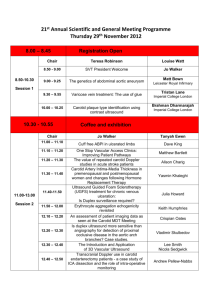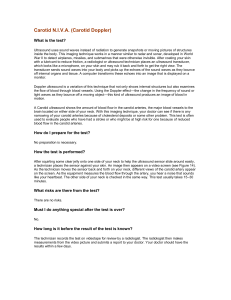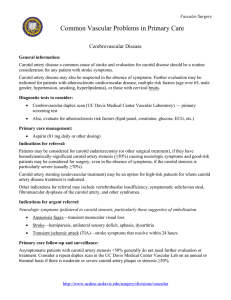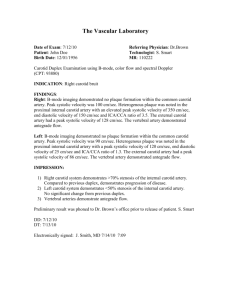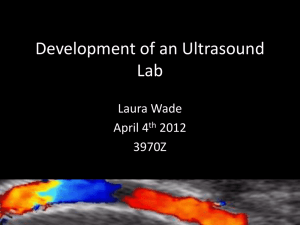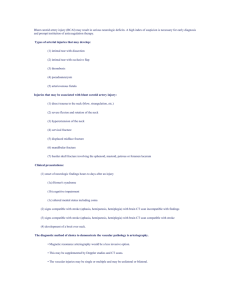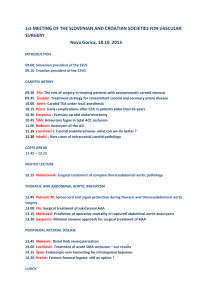Research Journal of Applied Sciences, Engineering and Technology 7(5): 1076-1082,... ISSN: 2040-7459; e-ISSN: 2040-7467
advertisement
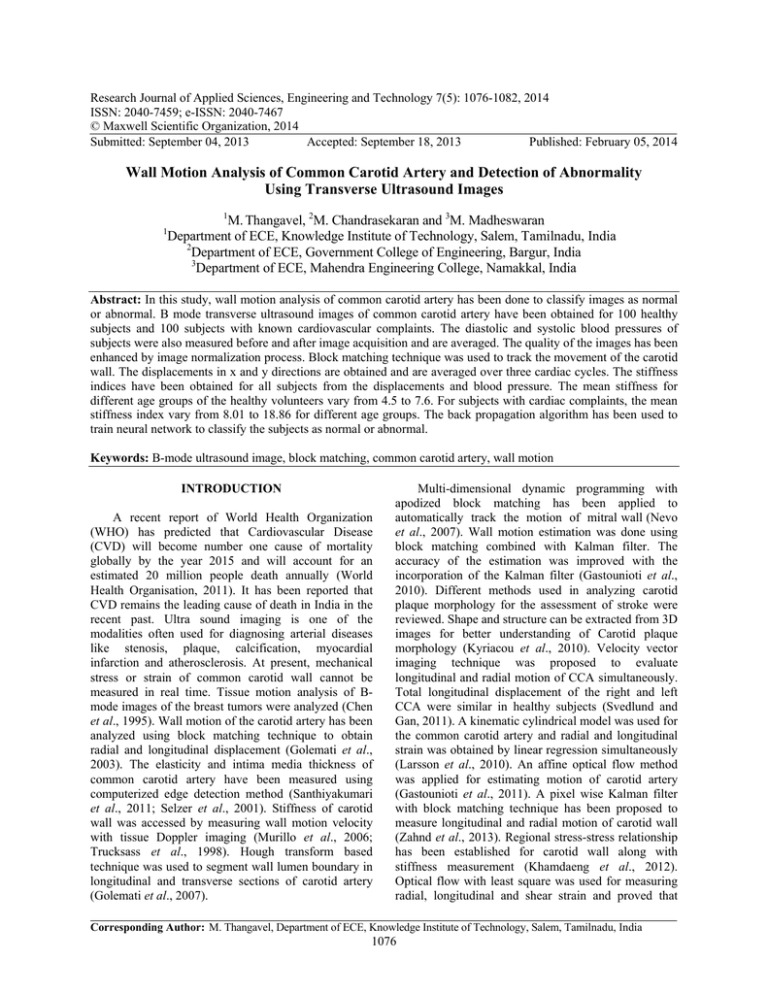
Research Journal of Applied Sciences, Engineering and Technology 7(5): 1076-1082, 2014 ISSN: 2040-7459; e-ISSN: 2040-7467 © Maxwell Scientific Organization, 2014 Submitted: September 04, 2013 Accepted: September 18, 2013 Published: February 05, 2014 Wall Motion Analysis of Common Carotid Artery and Detection of Abnormality Using Transverse Ultrasound Images 1 M. Thangavel, 2M. Chandrasekaran and 3M. Madheswaran Department of ECE, Knowledge Institute of Technology, Salem, Tamilnadu, India 2 Department of ECE, Government College of Engineering, Bargur, India 3 Department of ECE, Mahendra Engineering College, Namakkal, India 1 Abstract: In this study, wall motion analysis of common carotid artery has been done to classify images as normal or abnormal. B mode transverse ultrasound images of common carotid artery have been obtained for 100 healthy subjects and 100 subjects with known cardiovascular complaints. The diastolic and systolic blood pressures of subjects were also measured before and after image acquisition and are averaged. The quality of the images has been enhanced by image normalization process. Block matching technique was used to track the movement of the carotid wall. The displacements in x and y directions are obtained and are averaged over three cardiac cycles. The stiffness indices have been obtained for all subjects from the displacements and blood pressure. The mean stiffness for different age groups of the healthy volunteers vary from 4.5 to 7.6. For subjects with cardiac complaints, the mean stiffness index vary from 8.01 to 18.86 for different age groups. The back propagation algorithm has been used to train neural network to classify the subjects as normal or abnormal. Keywords: B-mode ultrasound image, block matching, common carotid artery, wall motion INTRODUCTION A recent report of World Health Organization (WHO) has predicted that Cardiovascular Disease (CVD) will become number one cause of mortality globally by the year 2015 and will account for an estimated 20 million people death annually (World Health Organisation, 2011). It has been reported that CVD remains the leading cause of death in India in the recent past. Ultra sound imaging is one of the modalities often used for diagnosing arterial diseases like stenosis, plaque, calcification, myocardial infarction and atherosclerosis. At present, mechanical stress or strain of common carotid wall cannot be measured in real time. Tissue motion analysis of Bmode images of the breast tumors were analyzed (Chen et al., 1995). Wall motion of the carotid artery has been analyzed using block matching technique to obtain radial and longitudinal displacement (Golemati et al., 2003). The elasticity and intima media thickness of common carotid artery have been measured using computerized edge detection method (Santhiyakumari et al., 2011; Selzer et al., 2001). Stiffness of carotid wall was accessed by measuring wall motion velocity with tissue Doppler imaging (Murillo et al., 2006; Trucksass et al., 1998). Hough transform based technique was used to segment wall lumen boundary in longitudinal and transverse sections of carotid artery (Golemati et al., 2007). Multi-dimensional dynamic programming with apodized block matching has been applied to automatically track the motion of mitral wall (Nevo et al., 2007). Wall motion estimation was done using block matching combined with Kalman filter. The accuracy of the estimation was improved with the incorporation of the Kalman filter (Gastounioti et al., 2010). Different methods used in analyzing carotid plaque morphology for the assessment of stroke were reviewed. Shape and structure can be extracted from 3D images for better understanding of Carotid plaque morphology (Kyriacou et al., 2010). Velocity vector imaging technique was proposed to evaluate longitudinal and radial motion of CCA simultaneously. Total longitudinal displacement of the right and left CCA were similar in healthy subjects (Svedlund and Gan, 2011). A kinematic cylindrical model was used for the common carotid artery and radial and longitudinal strain was obtained by linear regression simultaneously (Larsson et al., 2010). An affine optical flow method was applied for estimating motion of carotid artery (Gastounioti et al., 2011). A pixel wise Kalman filter with block matching technique has been proposed to measure longitudinal and radial motion of carotid wall (Zahnd et al., 2013). Regional stress-stress relationship has been established for carotid wall along with stiffness measurement (Khamdaeng et al., 2012). Optical flow with least square was used for measuring radial, longitudinal and shear strain and proved that Corresponding Author: M. Thangavel, Department of ECE, Knowledge Institute of Technology, Salem, Tamilnadu, India 1076 Res. J. App. Sci. Eng. Technol., 7(5): 1076-1082, 2014 US image Image normalization Block matching Displacement (x+ and x-) Displacement (y+ and y-) Displacement in x Displacement in y Computation of stiffness index Classification Fig. 1: Block diagram of proposed method warping index was the lowest for the method (Golemati et al., 2012). An adaptive block matching method using Kalman filter has been used for carotid wall motion and tracking error was reduced (Gastounioti et al., 2011). The displacement pattern of individual subjects has been studied and found that the pattern was stable over a period of time (Ahlgren et al., 2012). Analysis of carotid artery images provides valuable information in assessing CVD. Early detection of abnormalities can prevent CVD. In cardiovascular treatment, radial movement of the carotid artery wall is studied extensively by physicians and radiologist. It can be measured from B-Mode transverse ultra sound images using block matching. Motion of the carotid artery wall is due to blood pressure, blood flow and tethering to the surrounding tissues. This motion occurs in three directions, namely radial movement, longitudinal movement and direction perpendicular to radial and longitudinal directions. The longitudinal BMode carotid artery image can be used only for measuring radial and longitudinal displacements. But the movement in the third direction cannot be measured in longitudinal images. This movement can be measured in transverse B-Mode images. In this proposed study, motion of CCA in third direction has been estimated using ultrasound B-mode transverse section images. Figure 1 shows the block diagram of the proposed method. The movement of the CCA walls has been tracked with block matching technique. Normalized cross correlation parameter is used to identify the similarity nature of the blocks. The displacements in both vertical and horizontal directions have been tracked. Using these displacements stiffness indices are evaluated and subjects are also classified as normal or abnormal. METHODOLOGY Image acquisition: The B-Mode transverse ultrasound image has been acquired using Philips HD11XE US machine (Model No-HDI5000 sonoct) with the broadband compact linear array transducer. A multi frequency linear transducer with a frequency range of 7-15 MHz has been used for recording the arterial movements. The transducer is operated at a frequency of 12 MHz to obtain the arterial movements and the movements are recorded using video recorder. The video is recorded for a period of 10 sec for each subject to show the transverse sections of the CCA. The diastolic and systolic blood pressures have been measured before and after the image acquisition and are averaged. The recorded video is converted into frames using video de-compiler. The processed frames are stored as still images in a computing system for further processing. Image normalization procedures: The acquired images are processed for changing the pixel intensity 1077 Res. J. App. Sci. Eng. Technol., 7(5): 1076-1082, 2014 Fig. 2: Schematic of block matching technique values by contrast stretching. The normalization process minimizes variations introduced by different gains, different operators and different machines. Due to normalization the intensity values are mapped between 0 and 255. Let xmin and xmax are the minimum and maximum pixel values of the un-normalized image. To normalize the image, all the pixel values are first converted to a different range 0 and xm by subtracting xmin from all the pixel values. Then resultant pixel values are multiplied by 255 and divided by xmax - xmin. A pixel xk is normalized to get yk using the following formula: yk = x k − x min × 255 x max − x min (1) Block matching: The block matching has been used to estimate wall motion of the B-Ultrasound common carotid artery images (Golemati et al., 2003). Figure 2 illustrates the block matching procedure clearly. In block matching, a block of pixels is given in the reference frame. The aim is to find a block in the given frame that best matches the reference block. The searching is done in the given frame with in the search region. The size of the search region decides accuracy of the matching technique. To identify a matched block in the given frame (k), the correlation between reference block and a block of pixels in the search region is obtained. The block with maximum correlation coefficient is selected as a matched block. Normalized Cross Correlation (NCC) is the metric used for block matching (Chen et al., 1995; Kawasaki et al., 1987). NCC is defined as: where, I (x, y) = The intensity of the pixel at (x, y) in the reference block = The mean value of the I I w = The search window = The mean value of the w w The seed point is initialized in the middle of the lumen area, which act as a reference point, as shown in Fig. 3. In this proposed work block size of 2.5×2.5 mm is considered in wall lumen interface. The four blocks with the size of 2.5×2.5 mm are selected in wall lumen interfaces at angles of 0°, 90°, 180° and 270°. The centroids of the block of pixels are obtained by obtaining gradient at the wall lumen interface. The distance between seed point and centroid of the block is rx. Algorithm of the proposed study: The following steps explain the proposed study: Normalized cross correlation = ∑∑ ( I ( x, y ) − I ) ⋅ ( w ( x + ∆x, y + ∆y ) − w ) ∑∑ ( I ( x, y ) − I ) ⋅ ( w ( x + ∆x, y + ∆y ) − w ) 2 (2) 2 Fig. 3: Block chosen at wall lumen interface at 0° 1078 Res. J. App. Sci. Eng. Technol., 7(5): 1076-1082, 2014 Step 1: Initialize a seed point (x0, y0) in the middle of the lumen area. Step 2: Identify block of pixel in the wall lumen interface from seed point at an angles of 0°, 90°, 180° and 270°. Step 3: Find a best matching block in the subsequent frames within the search region using normalized cross correlation. Step 4: Find the displacements of the vessel wall in x+, x-, y+ and y- directions. Step 5: Calculate the diameter of the vessel wall in x and y directions. Step 6: Compute displacement and stiffness index. Step 7: Apply suitable classifier to identify normal and abnormal subjects. Wall motion of CCA: Carotid artery wall motion can be analyzed using block motion to obtain displacement of the artery wall during a cardiac cycle. Various methods are used to estimate CCA wall motion. Carotid stiffness index is a widely used metric for stiffness (Golemati et al., 2003). The stiffness of the wall is higher for patients with cardio vascular diseases. The maximum and minimum diameters of the wall corresponding to systolic and diastolic pressures are calculated. The stiffness of the wall is calculated by observing movement of the common carotid artery for many cardiac cycles. The strain and stiffness index β are given by: Strain = β= SD − DD DD ln ( SBP / DBP ) strain (3) (4) where, SBP = Systolic blood pressure DBP = Diastolic blood pressure SD = Systolic diameter DD = Diastolic diameter In the testing phase, the weights obtained in the testing phase are used. The stifness index and age from the database are given and the subjects considered are classified as normal subjects or abnormal subjects with cardiovacular or cerebrovascular disease. The algorithm for the BPN is as follows: Algorithm: Step 1: Initialise the weight, bias and residula error or error threshold Step 2: Read Input Step 3: Calculate the output Step 4: Calculate the mean square error Step 5: If mean square error is within the accepatble limit or if number of specified interation is reached stop ther training. other wise update the weight and go to next iteration RESULTS AND DISCUSSION In the proposed study, B mode Transverse ultrasound images are considered. One hundred healthy subjects with no symptoms of cardio vascular diseases and 100 subjects with cardio vascular diseases. The CCA B-Mode transverse images are acquired with subjects lying in supine position. The diastolic and systolic blood pressures are also measured for all the subjects. The acquired images are processed using MATLAB software. Figure 4 shows the input image of the proposed study. The seed point is initialized to fix the reference point in the middle of the lumen area. Four blocks with size of 2.5×2.5 mm are considered at angles of 0°, 90°, 180° and 270° as shown in Fig. 5. The image acquired for a subject with plaque is shown in Fig. 6. Block matching is applied for all the four blocks in the subsequent frames to track the wall lumen interface. The centroid of the block is considered for obtaining the displacement. The normalized cross correlation has been used as a similarity measure to Classification using backpropagation: In this study, Back Propagation Network algorithm (BPN) has been used for classification of images in to normal or abnormal. The back propagation architecture has input layer, hidden layer and output layer. The neural netwrok impletemented in following two phases: • • Training phase Testing phase In the training phase, the network is trained and an optimum weight for hidden layer has been obtained by giving age and carotid stifness ondex to the input layer. Fig. 4: A sample CCA image 1079 Res. J. App. Sci. Eng. Technol., 7(5): 1076-1082, 2014 Displacement in y direction 7.7 7.6 Displacement in mm 7.5 7.4 7.3 7.2 7.1 7 Fig. 5: Block representation at 0°, 90°, 180° and 270° in sample image 6.9 0 0.5 1 1.5 2 Time in seconds 2.5 3 3.5 Fig. 8: Displacement in Y direction Fig. 6: An abnormal subject with plaque Displacement in X direction 7.6 7.5 Displacement in mm 7.4 7.3 7.2 7.1 7 6.9 6.8 0 0.5 1 1.5 2 Time in seconds Fig. 7: Displacement in X direction 2.5 3 3.5 locate the best matched block. The distance between centroid of the block and reference point are denoted by rx+, rx-, ry+, ry-. The diameter in the x direction is obtained from rx+ and rx-. ry+, ry- are used to obtain displacement in y direction. The systolic and diastolic diameters are obtained in both x and y directions and are averaged to find the average displacement Fig. 7 and 8. The Table 1 shows mean and standard deviation of age, systolic blood pressure and diastolic blood pressure, diameter of carotid artery during systole and diastole and stiffness index obtained for 48 normal male subjects and 52 normal female subjects. The stiffness indices of both female and male subjects increase with age. For male subjects mean stiffness index varies from 4.5 to 7.3. For female normal subjects, the stiffness index varies from 4.8 to 7.65. All the subjects considered are without any symptom of cardiovascular symptoms. These results agree with other measurement obtained using other standard techniques. The Table 2 shows mean and standard deviation of age, systolic blood pressure, diastolic blood pressure, diameter of carotid artery during systole and diastole, diameter of carotid artery and stiffness index obtained for 46 male subjects and 54 female subjects with known cardiovascular symptoms. The stiffness indices of both female and male subjects increase with age. For male Table 1: Stiffness index for healthy subjects Male --------------------------------------------------------------------Age interval 21-35 36-50 51-65 Above 65 Number of subjects n 11 9 16 12 Age in years 29±3.80 43.60±6.30 59.50±4.10 70.70±2.5 SBP in mmHg 121±2.30 118±5.70 123±2.90 121±6.5 DBP in mmHg 77±3.10 72±4.10 79±3.60 78±4.8 Ds in mm 7.8±2.10 7.95±2.50 8.05±2.30 7.95±2.1 Dd in mm 7.1±2.20 7.30±2.30 7.50±2.00 7.50±1.9 ∆D in mm 0.7±0.25 0.65±0.23 0.55±0.22 0.45±0.2 Stiffness index β 4.5±1.90 5.15±1.70 6.70±1.70 7.30±1.4 1080 Female ---------------------------------------------------------------------21-35 36-50 51-65 Above 65 15 13 11 13 27.50±4.60 41.50±4.20 59.30±4.10 69.30±2.80 117±3.10 116±3.90 122±4.20 120±5.20 76±3.40 77±5.30 79±4.40 79±5.10 7.51±2.70 7.76±2.40 7.70±1.90 8.58±2.00 6.90±2.30 7.20±2.20 7.20±2.00 8.10±1.30 0.61±0.26 0.56±0.24 0.50±0.19 0.48±0.14 4.80±2.00 5.20±1.90 6.27±1.40 7.60±1.30 Res. J. App. Sci. Eng. Technol., 7(5): 1076-1082, 2014 Table 2: Stiffness index for abnormal subjects Male Female -------------------------------------------------------------------- ---------------------------------------------------------------------Age interval 40-50 51-60 61-70 Above 70 40-50 51-60 61-70 Above 70 Number of subjects n 16 11 10 9 18 15 11 10 Age in years 46.19±2.10 56.20±2.6 66.80±3.30 71.20±5.20 45.80±2.60 54.80±4.20 66.50±2.3 73.90±4.10 SBP in mmHg 130±3.40 135±5.1 139±6.00 141±5.40 126.70±3.50 135±4.50 137±4.2 142±2.50 DBP in mmHg 75±3.40 78±4.1 79±4.00 85±5.80 78.40±2.20 81±3.40 82±3.9 83±4.10 Ds in mm 7.78±2.20 8.03±2.0 8.54±1.60 8.65±1.40 8.30±2.30 8.47±2.20 8.57±1.9 8.65±1.60 Dd in mm 7.30±2.30 7.60±2.0 8.20±1.70 8.40±1.30 7.90±2.40 8.10±2.10 8.30±1.8 8.40±1.50 ∆D in mm 0.48±0.24 0.43±0.2 0.34±0.13 0.25±0.11 0.40±0.26 0.37±0.22 0.27±0.2 0.25±0.17 Stiffness index β 8.01±2.24 9.93±3.2 14.28±3.60 17±3.90 9.91±2.15 11.75±2.90 16.10±3.5 18.86±3.90 SBP: Systolic blood pressure; DBP: Diastolic blood pressure; Ds: Systolic diameter; Dd: Diastolic diameter; ∆D: Displacement of artery subjects, mean stiffness index varies from 8.01 to 17. For female subjects, the stiffness index varies from 9.91 to 18.86. The subjects considered have either one vessel disease or two vessel disease. CONCLUSION Wall motion analysis of common carotid artery has been studied by applying block matching technique for B-Mode transverse ultrasound images. The normalized cross correlation has been applied for finding the movement of the wall motion in successive frames. The displacement has been obtained by considering it in two perpendicular directions. The stiffness indices for male and female normal subjects are less than 8.5. The abnormal subjects have got stiffness indices above 8.0. Using the stiffness values obtained and age of the subjects, neural network with the back propagation has been trained. During testing phase, our system is able to classify the given image as normal and abnormal. Thus the present study can be applied for identifying abnormalities in CCA images for better diagnosis by giving additional information for physicians in better decision making. REFERENCES Ahlgren, A.R., M. Cinthio, H.W. Persson and K. Lindstrom, 2012. Different patterns of longitudinal displacement of the common carotid artery wall in healthy humans are stable over a four-month period. Ultrasound Med. Biol., 38(6): 916-925. Chen, E.J., R. Adler and W.K. Jenkins, 1995. Tissue motion analysis of digitized B-scan images of breast tumors. Proceedings of IEEE Ultrasonics Symposium, pp: 1177-1180. Gastounioti, A., S. Golemati, J. Stoitsis and K.S. Nikita, 2010. Kalman-filter-based block matching for arterial wall motion estimation from B-Mode ultrasound. Proceeding of IEEE International Conference on Imaging Systems and Techniques (IST), pp: 234-239. Gastounioti, A., S. Golemati, J. Stoitsis and K.S. Nikita, 2011. Comparison of Kalman-filter-based approaches for block matching in arterial wall motion analysis from B-mode ultrasound. Meas. Sci. Technol., 22: 9. Golemati, S., J. Stoitsis, E.G. Sifakis, T. Balkisas and K.S. Nikita, 2007. Using the Hough transform to segment ultrasound images of longitudinal and transverse sections of the carotid artery. Ultrasound Med. Biol., 33(12): 1918-1932. Golemati, S., A. Sassano, M.J. Lever, A.A. Bharath, S. Dhanjil and A.N. Nicolaides, 2003. Carotid artery wall motion estimated from B-mode ultrasound using region tracking and blockmatching. Ultrasound Med. Biol., 29(3): 387-399. Golemati, S., J.S. Stoitsis, A. Gastounioti, A.C. Dimopoulos, V. Koropouli and K.S. Nikita, 2012. Comparison of block matching and differential methods for motion analysis of the carotid artery wall from ultrasound images. IEEE T. Inf. Technol. B., 16(5): 852-858. Kawasaki, T., S. Sasayaas, A. Yagi and T. Hirai, 1887. Non-invasive assessment of the age related changes in stiffness of major branches of the human arteries. Cardiovascular, 21: 678-87. Khamdaeng, T.A., J. Luo, J. Vappou, P. Terdtoon and E.E. Konofagou, 2012. Arterial stiffness identification of the human carotid artery using the stress-strain relationship in vivo. Ultrasonics, 52: 402-411. Kyriacou, E., C. Pattichis, M. Pattichis, C. Loizou, C. Christodoulou, S. Kakkos and A. Nicolaides, 2010. A review of noninvasive ultrasound image processing methods in the analysis of carotid plaque morphology for the assessment of stroke risk. IEEE T. Inf. Technol. B., 14(4): 1027-1038. Larsson, M., F. Kremer, P. Claus, L.A. Brodin and J. D'hooge, 2010. Ultrasound-based 2D strain estimation of the carotid artery: An in-silico feasibility study. Proceeding of IEEE International Ultrasonics Symposium (IUS), pp: 459-462. Murillo, S.E., M.S. Pattichis, C.P. Loizou, C.S. Pattichis, E. Kyriacou, A.G. Constantinides and A. Nicolaides, 2006. Atherosclerotic plaque motion trajectory analysis from ultrasound videos. Proceeding of 5th IEEE EMBS Spec. Topic Conf. Inf. Tech. Biomed, pp: 5. 1081 Res. J. App. Sci. Eng. Technol., 7(5): 1076-1082, 2014 Nevo, S.T., M.V. Stralen, A.M. Vossepoel, J.H.C. Reiber, N.D. Jong, A.F.W.V. Steen and J.G. Bosch, 2007. Automated tracking of the mitral valve annulus motion in apical echocardiographic images using multidimensional dynamic programming. Ultrasound Med. Biol., 33(9): 1389-1399. Santhiyakumari, N., P. Rajendran, M. Madheswaran and S. Suresh, 2011. Detection of the intima and media layer thickness of ultrasound common carotid artery image using efficient active contour segmentation technique. Med. Biol. Eng. Comput., 49(11): 1299-310. Selzer, R.H., W.J. Mack, P.L. Lee, H.K. Fu and H.N. Hodis, 2001. Improved common carotid elasticity and intima-media thickness measurements from computer analysis of sequential ultrasound frames. J. Atheroscler., 154: 185-193. Svedlund, S. and L.M. Gan, 2011. Longitudinal wall motion of the common carotid artery can be assessed by velocity vector imaging. Clin. Physiol. Funct. I., 31: 32-38. Trucksass, A.S., D. Grathwohl, A. Gastounioti, N.N. Tsiaparas, S. Golemati, J.S. Stoitsis, K.S. Nikita, J. Keul and M. Huonker, 1998. Affine optical flow combined with multiscale image analysis for motion estimation of the arterial wall from B-mode ultrasound. Proceeding of 33rd Annual International Conference of the IEEE EMBS, Assessment of Carotid Wall Motion and Stiffness with Tissue Doppler Imaging. Ultrasound Med. Biol., 24(5): 639-646. World Health Organisation, 2011. Fact Sheet No. 317. Retreieved form: www.who.int. Zahnd, G., M. Orkisz, A. Serusclat, P. Moulin, D. Vray, 2013. Evaluation of a Kalman-based block matching method to assess the bi-dimensional motion of the carotid artery wall in B-mode ultrasound sequences. Med. Image Anal., 17(5): 573-585. 1082

